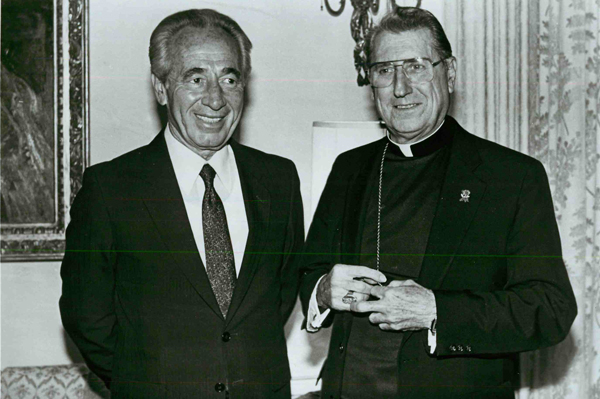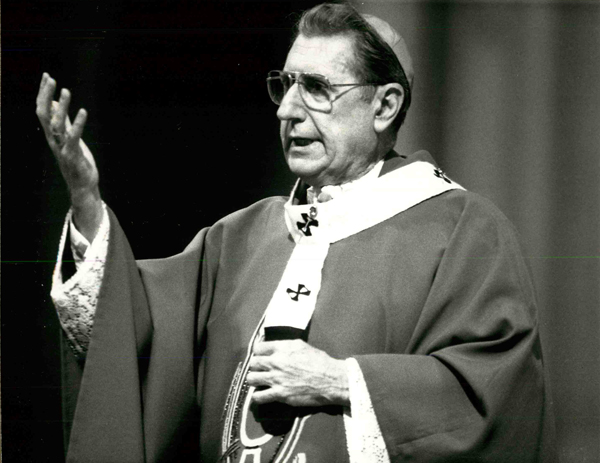(RNS) In April 1908, Dorothy Gumple, a 19-year-old Jewish woman living in Connecticut, converted to Roman Catholicism. Less than two years, later she married a Catholic immigrant from Ireland. They and their five children lived in Philadelphia where her husband was a lifelong trade union member. It is not exactly the stuff global news stories are made of.
Except this: Their fourth child became the world-famous archbishop of New York, Cardinal John J. O’Connor, who served in that position from 1984 until his death in 2000.

Then-Israeli Prime Minister Shimon Peres, left, and New York’s Cardinal John O’Connor met on Sept. 19, 1986 at the cardinal’s residence in New York. Religion News Service file photo by Chris Sheridan
Last month, in the Catholic New York newspaper, the cardinal’s 87-year-old sister, Mary, revealed the story of their mother’s conversion for the first time, and claimed she and her brother “did not know (our) mother was Jewish.” The O’Connor children “presumed that she had converted from another Christian religion.”
She concluded her article extolling her brother’s extraordinary relations with the Jewish people and declared that God “used my brother, this son of a Jewish mother and a Catholic father, to be the instrument that built so many bridges between the Jewish and Catholic communities.”
As the interreligious affairs director for the American Jewish Committee, I worked closely with Cardinal O’Connor during his years in New York. But I — and presumably he — never knew of his mother’s religious history. I always marveled at his commitment to fight all forms of anti-Semitism and his strong support of Israel’s quest for survival and security. His many public and private efforts played a key role in the establishment of formal diplomatic relations between the Vatican and Israel, and he was an ally in the struggle to free Soviet Jewry.
During our years of working together, there were flashpoints and moments of high tension that threatened to undermine the positive gains in Catholic-Jewish relations. While we always addressed one another in public by using our formal titles, it was a different story in our one-on-one personal meetings and during private telephone conversations. Then it was simply “John” and “Jim” trying to solve critical problems that demanded attention.
One reason for our mutual respect was the fact that both of us had been military chaplains. Although O’Connor had served for nearly 30 years in the Navy and I only two years with the Air Force, we both knew that chaplains had to work together in close quarters in a spirit of collegiality, consultation, and shared goals.
In June 1987, our friendship was both tested and ultimately strengthened when Pope John Paul II received Austrian President Kurt Waldheim at the Vatican with full honors. At the time, Waldheim was living under an ugly public shadow because he had hidden his wartime record as a German officer in the Balkans where he was involved in the murder of Jews and Eastern Orthodox Christians. The warm Vatican welcome for Waldheim upset many Jewish and Catholic leaders, including O’Connor.
At the time, I was in Germany participating in a Lutheran-Jewish conference. One night, while asleep in my hotel room, the phone rang. “Sorry if I woke you,” said the familiar voice with the distinct Philadelphia accent. “Jim, this is John. I really wish you were in New York now. You could be of big help to me with the problems created by the Waldheim visit. When are you coming back? We need you here.”
Even in the last months of his life when he was stricken with a fatal brain tumor, O’Connor remained humorous and jovial. Wherever I asked him how things were going, he always replied, “Every day’s a holiday!” The last time my wife and I saw him, he repeated his cheerful mantra, and when we embraced, we both knew he was terminally ill. I turned away in tears.
While it is for Catholics to evaluate his record as a cardinal, he has already earned a beloved place in Jewish history. And this I also know: He would have been a great rabbi.
(Rabbi A. James Rudin, the American Jewish Committee’s senior interreligious adviser, is the author of the recently published “Cushing, Spellman, O’Connor: The Surprising Story of How Three American Cardinals Transformed Catholic-Jewish Relations.”)
KRE/AMB END RUDIN






